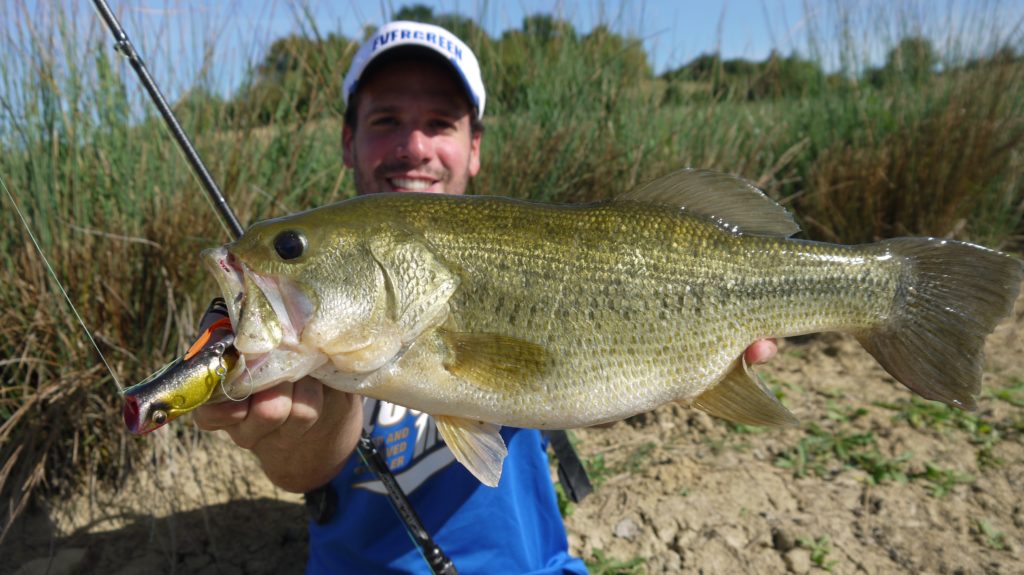
Today we are going to talk about lures for fishing in seagrass beds and the different possible techniques so as not to see seagrass beds as a handicap, but rather as an asset.
- Fishing in seagrass beds: a very specific technique
- The frog: The lure par excellence for fishing in seagrass beds on the surface
- The texas rig or texan rig: A technique for fishing deep seagrass beds
- Swimming shads: a category well suited for seagrass fishing
- The spinnerbait: the go-anywhere lure
- The lipless: the reaction lure
- The buzzbait: A perfect lure for fishing in seagrass beds
- Liens utiles liés à cet article pour pêcher dans les hebiers
Fishing in seagrass beds: a very specific technique
Most of the aquatic vegetation thrives during summer periods generally between fifty centimeters and four meters in depth. This information will guide us on the choice of lures to fish the seagrass properly and in good conditions.

This period corresponds to the right moment for predators to protect themselves but also to hunt prey while being camouflage. We are especially thinking of pike and black bass, which take advantage of this period to attack their prey on the surface.
The fact remains that fishing for pike in seagrass beds or black bass requires suitable lures, techniques and equipment. Here are a few.
The frog: The lure par excellence for fishing in seagrass beds on the surface
The frog is a category of lure which passes best through all kinds of obstacles (seagrass, dead wood, vegetation, rocks, etc.). It is therefore normal to be interested in this category when choosing lures for fishing in seagrass beds. The armament of the frogs is designed not to catch on thanks to the hooks which come close to the body of the frog (texposed).

The frog is therefore a lure perfectly suited to fishing in seagrass beds.It is a summer lure, and as said previously, seagrass beds are at their maximum development in summer.
When you fish in the seagrass beds with the frog, we advise you to fish in direct braid, without fluoro leader, there is no need. One of the advantages is to remove the weak point of the connection node. Another advantage is that there will be less grass beds that get stuck along your line without the connecting knot.

The texas rig or texan rig: A technique for fishing deep seagrass beds
The Texan rig is a rig that will allow you to fish all the gaps in the seagrass beds. The goal is to associate a soft lure (creature, worms, crayfish, etc.) with a rig with texan hook or widegap type (more curved than the Texan hook) and a cone-shaped sinker to be able to ballast the lure.

When you fish in the seagrass in texas rig, we also advise you not to take the lead sinker. This is for two reasons:
- Firstly, lead is not an ecological component. It dissolves in water, pollutes it and leaves traces of its presence.
- Second, the lead does not reason enough in the cane to let you know. In order to know if the bottom is hard or soft, the use of tungsten cones is more suitable.

Swimming shads: a category well suited for seagrass fishing
It is a category of lure which adapts very well to fishing seagrass in many cases. When your seagrass beds are fifty centimeters below the surface, the shads adapt perfectly. You can thus cover a large fishing area in a minimum of time.
It is possible to fish with widegap hooks so that you really don't catch anything in the process. If the herbaria are not too dense, it is even possible to use a jig head equipped with a triple thief. This family of lures is aimed a lot at the fish on the prowl.

The spinnerbait: the go-anywhere lure
Spinnerbaits are lures that fish very well for seagrass, especially large models. Their tapered shape gives them an incomparable fluidity of movement compared to other types of lures.

It is possible to bring them back very quickly by letting the pallets create swirls under the surface. You can also fish the gaps in the seagrass beds with jagged animations. It is important to fish with relatively thin braids. This allows the herbaria to be cut with a sharp blow with the cane.
The lipless: the reaction lure
The vibrations are lures which also allow seagrass fishing in excellent conditions. They provoke the reaction of predators in the same way as spinnerbaits but in an even more aggressive way. This is linked to the sound presence caused by the balls of the lure.

These are quick prospecting lures. If you need to cover some distance or select active fish, we highly recommend them.
The buzzbait: A perfect lure for fishing in seagrass beds
It is surely one of the revealing lures in seagrass fishing. In the United States, pro fishermen did not hesitate to take out this metal propeller lure to unleash big attacks on the surface. It is equipped with a single hook tilted upwards, so as not to catch grass.
In the Toulouse region, the precursor of this lure is none other than Philippe Amiel. He showed many fishermen in the region that the summer use of buzzbait was particularly effective for fishing for pike and balck-bass in seagrass beds, especially by varying the speed of recovery erratically.
Useful links linked to this article to fish in the hebiers
The 10 best types of black bass lures




